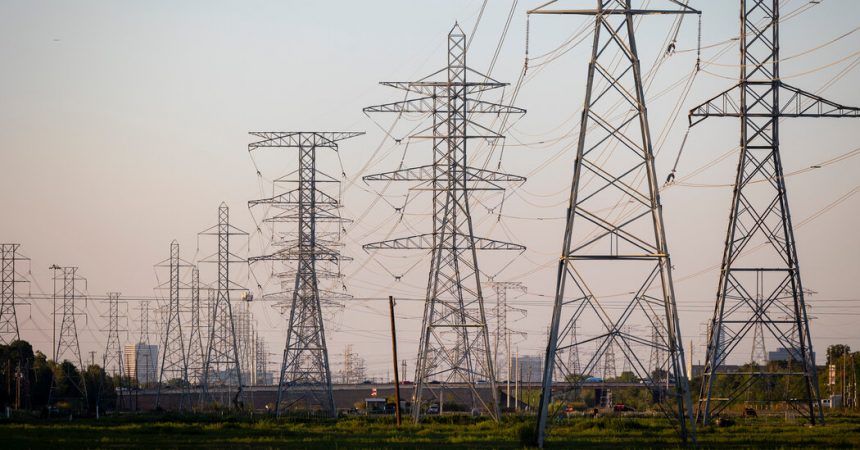The Federal Energy Regulatory Commission may be the most important climate agency you’re never heard of.
Responsible for overseeing interstate transmission of gas, oil and electricity, the independent agency could help determine how much wind, solar and other renewable energy moves from engineering plans onto the nation’s electric grids and into homes and businesses.
On Monday the commission approved long-awaited changes that require grid operators around the country to plan 20 years into the future, taking into account changes in the energy mix, the growing number of states that have policies requiring wind and solar power, as well as the risks that extreme weather poses to reliability.
The vote was 2 to 1, with the commission’s Democrats approving and the sole Republican objecting, a partisan split that echoed the divide between the two parties over renewable energy.
Senator Chuck Schumer of New York, the Democratic leader, said the decisions made by the commission on Monday were critical to realizing the full extent of the Inflation Reduction Act, the sweeping climate law that Democrats muscled through without Republican support in 2022. The law provides tax incentives of more than $370 billion to jump start electric vehicles and wind, solar and other renewable energy.
But many of those energy projects have been in limbo, unable to connect to electric grids because of a lack of new transmission lines. One study warned that roughly half of the climate benefits under the law could not be realized if transmission capacity, including new high voltage power lines, was not expanded significantly.
“It was a great victory after the I.R.A. was passed, and we got plaudits all around, but I knew even as I was standing up smiling that our work wasn’t done,” Mr. Schumer said last week in an interview. “If you have lovely windmills in the mountains but you can’t bring it to where the people were, it might be for nought. It became clear early on that transmission was so important, that it would be a linchpin in developing clean energy.”
The agency was created in 1920 as the Federal Power Commission to control hydropower dams. President Franklin D. Roosevelt later championed legislation to dismantle utility monopolies, and in 1935 Congress passed the Federal Power Act, requiring the commission to set “just and reasonable” wholesale electricity prices.
In the 1970s, it became the Federal Energy Regulatory Commission, or FERC, and got an expanded mandate to regulate interstate electricity, hydroelectric projects and oil and gas pipelines.
“The transmission pipeline infrastructure of the entire country runs through this one agency,” said Rob Gramlich, the president of Grid Strategies, a power sector consulting firm. “Most people who are involved with FERC are happy when it stays out of the news,” he added.
In recent years, the commission has become a focal point for the connection between the power grid and climate change. Utilities that burn gas and coal to produce electricity are the second largest source of the pollution that is driving global warming.
In 2021 Richard Glick, who had been appointed to chair the commission by President Biden, said the agency should more fully consider the impacts of climate change when approving natural gas pipelines.
With that focus on climate change, came controversy.
Senator Joe Manchin, the West Virginia Democrat and champion of coal and gas, was irate that Mr. Glick was saying climate change should be a consideration during pipeline discussions. As chairman of the Senate Energy and Natural Resources Commission, Mr. Manchin refused to hold a confirmation hearing for Mr. Glick, who ultimately stepped down.
His departure left the commission with a 2-2 partisan split. Under FERC’s rules, no more than three of its five commissioners may be from a single party.
To hear Mr. Schumer tell it, that’s when Democratic strategizing went into high gear.
Efforts to hammer out bipartisan legislation to speed up electricity transmission remain in limbo. Democrats want to speed up the pace of adding solar and wind to the grid while Republicans in return want faster and easier permitting for fossil fuel projects and pipelines.
Neil Chatterjee, who served as chairman of FERC under President Donald J. Trump said some Republicans have been reluctant to act on transmission because they don’t want the Inflation Reduction Act to succeed.
“The Republican Party used to be a party that led on transmission policy,” he said. But now “it’s seen as facilitating Biden achieving his climate agenda, and they’re against it just to be against Biden.”
Mr. Schumer said turning to FERC was a way to get around Republican opposition in Congress. “We always had FERC in the back of our minds because it could be done without congressional Republican approval,” he said.
When Mr. Glick stepped down, Mr. Schumer said he saw an opportunity. He learned that one of the two Republican commissioners, James Danly, was also poised to relinquish his seat. Mr. Danly left the agency in January, leaving a 2-1 commission in favor of Democrats with Willie L. Phillips, who was appointed by Mr. Biden, serving as chairman. (Nominees are still awaiting confirmation on the commission’s two empty seats.)
Mr. Schumer increased pressure on the commission to free up the congested transmission system, writing an open letter in July laying out proposed solutions.
On Monday Mr. Schumer said, “FERC is doing just about everything we asked” and called the rule the “missing piece of the puzzle” to the Inflation Reduction Act. He acknowledged that more must be done on transmission reform, but chances remain dim that Congress will act.







